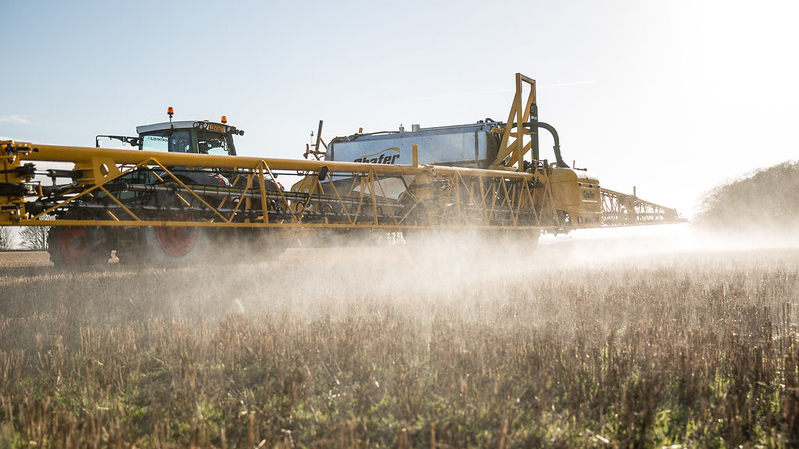While the chemical industry promotes no-till as ‘regenerative’ USDA data prove its reliance (in the USA) on toxic pesticides.

A new report from Friends of the Earth refutes the widely-held assumption that conventional no-till agriculture is ‘regenerative.’ Based on a first-of-its-kind analysis of U.S. Department of Agriculture (USDA) data, the report finds that most no-till systems are so heavily dependent on toxic herbicides to manage weeds that a staggering one-third of the U.S.’s total annual pesticide use (a term that includes herbicides, insecticides, and fungicides) can be attributed to no- and minimum-till corn and soy production alone.
Chemical-intensive agriculture predominates in the U.S. not through the fault of farmers, but because that is what public policies and markets support. Farmers have widely adopted no-till to minimize soil erosion and now must be supported to reduce agrochemical inputs.
The report finds that the vast majority (93%) of acreage of the top two no- and minimum-till crops, corn and soy, use toxic herbicides that have devastating consequences for soil life and human health. These chemicals, being broadcast across nearly 100 million acres nationwide, predominantly in the Heartland and Great Plains, have been linked to cancer, birth defects, infertility, neurotoxicity, disruption of the gut microbiome, endocrine disruption, and more. The majority (61%) of use is chemicals that are classified as highly hazardous. Glyphosate, the cancer-linked main ingredient in the widely criticised weedkiller Roundup, is the most widely used herbicide in no-till corn and soy.
The cost of chemical-intensive no-till goes beyond impacts on our health: It is also destroying the soil that grows our food. The pesticides widely used in conventional no-till devastate soil health, harming the soil microbiome and invertebrates like worms and beetles, as well as essential pollinators and other wildlife. Healthy, living soil improves farmers’ resilience to droughts and floods, conserves water, and draws more carbon down from the atmosphere. Soil ravaged by toxic pesticides, on the other hand, threatens resources needed for a healthy food system.
The report debunks the faulty assumption that conventional no-till is a climate solution, summarizing extensive scientific research showing there is no clear relationship between no-till and soil carbon sequestration. And the greenhouse gas emissions associated with the fossil-fuel-based synthetic pesticides and fertilizers used in no- and minimum-till corn and soy are equivalent to that of 11.4 million cars on the road over an entire year — about the number of cars in the top 9 no-till states combined.
“As regenerative agriculture takes center stage in national conversations about how to make America healthy, it’s crucial that we advance truly regenerative agriculture,” said Dr. Kendra Klein, Deputy Director of Science at Friends of the Earth. “Conventional no-till, soaked in toxic pesticides that threaten our children’s health, ravage soil, and exacerbate climate change, is taking us in the wrong direction.”
The ascendance of no-till is linked to the chemical industry’s attempt to deepen farmers’ dependence on their toxic products. Chemical companies such as Imperial Chemical Industries and Chevron conducted no-till experiments and helped spread the concept of industrial no-till in the 1970s, recognizing it as an opportunity to increase the market for their herbicides. Currently, pesticide giant Bayer is offering to pay farmers to practice no-till as part of their “regenerative agriculture” program.
“Major food companies investing in regenerative agriculture need to avoid greenwashed conventional no-till and instead support the transition to legitimately regenerative agriculture that will protect soil health, human health — and their future bottom line,” said Sarah Starman, Senior Campaigner of Food & Agriculture with Friends of the Earth.
Truly regenerative agriculture cannot be boiled down to single practices, it works with the farming system as a whole. Research shows that careful tillage in holistic farming systems can achieve better soil outcomes than chemical-intensive no-till agriculture.
A central tenet of truly regenerative agriculture is dramatic reduction of harmful agrochemicals. Research shows that reducing use of synthetic pesticides and fertilizers in conventional agriculture is not only possible, it can increase yields by fostering beneficial insects and healthy soil and can increase profitability by reducing farmers’ input costs.
A leading form of truly regenerative agriculture is organic farming. And unlike the term ‘regenerative,’ the USDA organic seal is enforced through a rigorous legal standard. Decades of research shows that organic farms, on average, improve soil health, climate resilience, and soil carbon sequestration; reduce emissions; and protect biodiversity, human health, and community wellbeing.
Key findings
